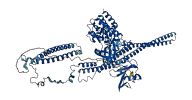Q9TTY2
Gene name |
FER |
Protein name |
Tyrosine-protein kinase Fer |
Names |
Proto-oncogene c-Fer, p94-Fer |
Species |
Canis lupus familiaris (Dog) (Canis familiaris) |
KEGG Pathway |
cfa:403754 |
EC number |
|
Protein Class |
|

Descriptions
The autoinhibited protein was predicted that may have potential autoinhibitory elements via cis-regPred.
Autoinhibitory domains (AIDs)
Target domain |
|
Relief mechanism |
|
Assay |
cis-regPred |
Accessory elements
No accessory elements
Autoinhibited structure

Activated structure

1 structures for Q9TTY2
| Entry ID | Method | Resolution | Chain | Position | Source |
|---|---|---|---|---|---|
| AF-Q9TTY2-F1 | Predicted | AlphaFoldDB |
No variants for Q9TTY2
| Variant ID(s) | Position | Change | Description | Diseaes Association | Provenance |
|---|---|---|---|---|---|
| No variants for Q9TTY2 | |||||
No associated diseases with Q9TTY2
No regional properties for Q9TTY2
| Type | Name | Position | InterPro Accession |
|---|---|---|---|
| No domain, repeats, and functional sites for Q9TTY2 | |||
Functions
6 GO annotations of cellular component
| Name | Definition |
|---|---|
| anchoring junction | A cell junction that mechanically attaches a cell (and its cytoskeleton) to neighboring cells or to the extracellular matrix. |
| cell cortex | The region of a cell that lies just beneath the plasma membrane and often, but not always, contains a network of actin filaments and associated proteins. |
| cell projection | A prolongation or process extending from a cell, e.g. a flagellum or axon. |
| cytoskeleton | A cellular structure that forms the internal framework of eukaryotic and prokaryotic cells. The cytoskeleton includes intermediate filaments, microfilaments, microtubules, the microtrabecular lattice, and other structures characterized by a polymeric filamentous nature and long-range order within the cell. The various elements of the cytoskeleton not only serve in the maintenance of cellular shape but also have roles in other cellular functions, including cellular movement, cell division, endocytosis, and movement of organelles. |
| nucleus | A membrane-bounded organelle of eukaryotic cells in which chromosomes are housed and replicated. In most cells, the nucleus contains all of the cell's chromosomes except the organellar chromosomes, and is the site of RNA synthesis and processing. In some species, or in specialized cell types, RNA metabolism or DNA replication may be absent. |
| plasma membrane | The membrane surrounding a cell that separates the cell from its external environment. It consists of a phospholipid bilayer and associated proteins. |
4 GO annotations of molecular function
| Name | Definition |
|---|---|
| ATP binding | Binding to ATP, adenosine 5'-triphosphate, a universally important coenzyme and enzyme regulator. |
| epidermal growth factor receptor binding | Binding to an epidermal growth factor receptor. |
| lipid binding | Binding to a lipid. |
| non-membrane spanning protein tyrosine kinase activity | Catalysis of the reaction: ATP + protein L-tyrosine = ADP + protein L-tyrosine phosphate by a non-membrane spanning protein. |
5 GO annotations of biological process
| Name | Definition |
|---|---|
| actin cytoskeleton reorganization | A process that is carried out at the cellular level which results in dynamic structural changes to the arrangement of constituent parts of cytoskeletal structures comprising actin filaments and their associated proteins. |
| cell population proliferation | The multiplication or reproduction of cells, resulting in the expansion of a cell population. |
| positive regulation of cell migration | Any process that activates or increases the frequency, rate or extent of cell migration. |
| positive regulation of NF-kappaB transcription factor activity | Any process that activates or increases the frequency, rate or extent of activity of the transcription factor NF-kappaB. |
| regulation of epidermal growth factor receptor signaling pathway | Any process that modulates the frequency, rate or extent of epidermal growth factor receptor signaling pathway activity. |
| 10 | 20 | 30 | 40 | 50 | 60 |
| MGFGSDLKNS | HEAVLKLQDW | ELRLLETVKK | FMALRIKSDK | EYASTLQNLC | NQVDKESTVQ |
| 70 | 80 | 90 | 100 | 110 | 120 |
| MNYVSNVSKS | WLLMIQQTEQ | LSRIMKTHAE | DLNSGPLHRL | TMMIKDKQQV | KKSFIGVHQQ |
| 130 | 140 | 150 | 160 | 170 | 180 |
| IEAEMIKVTK | TELEKLKSSY | RQLIKEMNSA | KEKYKEALAK | GKETEKAKER | YDKATMKLHV |
| 190 | 200 | 210 | 220 | 230 | 240 |
| LHNQYVLALK | GAQLHQNQYY | DTTLPLLLDS | LQKMQEEMIK | ALKGIFDEYS | QITSLVTEEI |
| 250 | 260 | 270 | 280 | 290 | 300 |
| VNVHKEIQMS | VEQIDPSTEY | NNFIDVHRTT | AAKEQEIEFD | TSLLEENENL | QANEIMWNNL |
| 310 | 320 | 330 | 340 | 350 | 360 |
| TAESLQVMLK | TLAEELIQTQ | QMLVNKEEAV | LELEKRIEES | SKTCEKKSDI | VLLLSQKQTL |
| 370 | 380 | 390 | 400 | 410 | 420 |
| EELKQSVQQL | RCTEAKFTAQ | KELLEQKVQE | NEGKEPPPVV | NYEEDARSVT | SMERKERLSK |
| 430 | 440 | 450 | 460 | 470 | 480 |
| FESIRHSIAG | IIRSPKSALG | SSTFSDTIPI | SEKPLAEQDW | YHGAIPRIEA | QDLLKQQGDF |
| 490 | 500 | 510 | 520 | 530 | 540 |
| LVRESHGKPG | EYVLSVYSDG | QRRHFIIQFV | DNLYRFEGTG | FSNIPQLIDH | HYTTKQVITK |
| 550 | 560 | 570 | 580 | 590 | 600 |
| KSGVVLLNPI | PKDKKWVLNH | EDVTLGELLG | KGNFGEVYKG | ILKDKTAVAV | KTCKEDLPQE |
| 610 | 620 | 630 | 640 | 650 | 660 |
| LKIKFLQEAK | ILKQYDHPNI | VKLIGVCTQR | QPIYIIMELV | PGGDFLSFLR | KKKDEIKLKQ |
| 670 | 680 | 690 | 700 | 710 | 720 |
| LVKFSLDAAS | GMSYLESKNC | IHRDLAARNC | LVGENNVLKI | SDFGMSRQED | GGVYSSSGLK |
| 730 | 740 | 750 | 760 | 770 | 780 |
| QIPIKWTAPE | ALNYGRYSSE | SDVWSFGILL | WETFSLGVCP | YPGMTNQQAT | EQVERGYRIS |
| 790 | 800 | 810 | 820 | ||
| APQHCPEDIF | KIMMKCWDYK | PENRPKFSEL | QKELTVIKKK | VTQ |